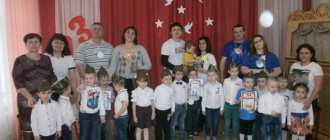Equipment for classes in kindergarten:
- record player,
- audio cassettes,
- children's musical instruments,
- doll - “conductor”,
- portraits of composers (F. Schubert, J. S. Bach, F. Chopin),
- album with photographs of musical instruments,
- screen,
- sultans.
Repertoire:
- “Dance” by F. Schubert;
- “The Joke” by J. S. Bach;
- “Waltz No. 17” by F. Chopin;
- organ music by J. S. Bach;
- musical and didactic game “Musical Instruments”;
- sedentary game "Orchestra".
____________________________ NOTE - You can buy toys for kindergarten in the specialized store "KINDERGARTEN" - detsad-shop.ru Low prices, discounts for kindergartens and children. committees, delivery!
____________________________
GCD in music in the senior group using ICT. Musical instruments
Lesson notes for the senior group of preschool educational institutions.
Introduction to musical instruments Goal: Development of musical abilities through playing noise instruments. Creation of conditions conducive to increasing the creative activity of children, expanding their musical horizons, awakening interest in all types of musical activities. Objectives: To attract children to perform tasks correctly, to develop sustained attention when completing them. To develop the ability to correctly name noise instruments, play them rhythmically, and listen to each other. Enrich children's vocabulary. Methods: Verbal (riddles, conversation).
Visual (presentation, noise instruments). Practical (playing with spoons, playing with a tambourine, dancing with rattles, song-dance). Gaming (game with a tambourine). Progress of the lesson
Children enter the hall to the music and stand in a general circle.
Musical greeting "Hello". COMMUNICATIVE GAME “HELLO” Hello, palms clap - clap - clap Hello, legs - top - top - top Hello, eyes - myrg, myrg, myrg Hello, my nose - peep - peep - peep Hello, ears - wow - wow - uh Hello, children, hello! Musical director: Guys, do you want to go on an excursion to the Town of Musical Instruments? Children's answers. Fine. What can you ride? (Children's answers.) ……………… offers by train. Do you agree? Get into the trailers, and the driver will be ………. Musical and rhythmic exercise “Train”. Slide.
A train rides through the forest. Musical and rhythmic exercise “Train”.
Children stand one after another, put their hands on the shoulders of the person in front and move with stomping steps around the hall to the music of “The Steam Locomotive” by L. Kompaneets. After the Rhythmic Warm-up, the children sit on chairs. Musical director. Guys, we have arrived in the Town of Musical Instruments. What instruments do you know? Children's answers. For some reason no one meets us. Let's knock on the first house and find out who lives in this house. Slide.
The teacher sets a rhythmic pattern, the children repeat. A riddle appears from one house. I'm round like the sun, only with bells I sound very loud, you will hear it yourself, When you take me in your hands, hit me with your palm I will sound loud, loud Guess who I am?
(Tambourine) Children's answers. That's right, guys, it's a tambourine. The tambourine is a percussion instrument because we hit it, and it responds to us with its ringing sound. Let's play with a tambourine. PLAYING WITH A TAMBISON Children stand in a circle, three children stand in a circle with tambourines. Children with tambourines beat the tambourine rhythmically to musical accompaniment, the rest of the children move in a circle. During the second part of the music, the children sit down and “fall asleep,” and the children with the tambourine quietly leave the circle, put the tambourines behind their comrades and sit down next to them. When a loud chord is heard, the children wake up, look around, find the tambourines, stand in a circle and the game continues. Well done guys, take your seats. What a funny tambourine, he even played with us. I wonder who lives in the next house? Let's knock. Slide. The music director sets a rhythmic pattern, and the children repeat it. A riddle appears from the house. Two daring, painted, Khokhloma girlfriends It’s impossible to be alone, do you recognize us, friends? (Spoons) That's right, guys, these are spoons. Look how beautiful, bright, painted, and made of wood they are. They play on spoons with their backs - humps, stroking them. Let's try how we can do it. Game with spoons. Well done, you and I have created an ensemble of spooners. Let's repeat the “ensemble of spoons.” Fine. Place the spoons back into the jug and let them rest. And we’ll look into another house and find out who lives there? Slide.
The music director sets a rhythmic pattern, and the children repeat it. A riddle appears from the house. If I fall into the hands of a child I’ll play loudly and loudly It’s not for nothing that it’s a funny toy And my name is….
(Rattle) That's right, guys, it's a rattle. They took the rattles in their hands They sounded loudly The rattles make you happy They don’t tell you to sit still Get up in a circle and start dancing with them! DANCE WITH RATTLES Well done, guys. We danced with all our hearts. But we have one more house that is not open. Who lives in it? We'll find out now. Slide.
The music director sets a rhythmic pattern, and the children repeat it. A riddle appears from the house. He sits under his cap, Don’t disturb him - he’s silent.
All you have to do is take it in your hands and swing it a little, you can hear the chime: “Dili-don, dili-don. (bell) Well done guys, look carefully, are all the houses open? Children's answers. Look how many musical instruments we have. Let's play in the orchestra. Playing children's musical instruments. Guys, did you enjoy the tour? Where have we been? What instruments did you come across? Would you like to visit the Town of Musical Instruments again? It was a pleasure traveling with you today. But it's time for us to say goodbye to you.
We recommend watching:
Summary of educational activities for the senior group on the topic: Autumn Summary of educational activities in the senior group “Journey to the magical world of musical instruments” Summary of educational activities in the senior group “Visiting Domisolka” Thematic music lesson in a preschool educational institution. Senior group
Similar articles:
Conversation in the senior group of kindergarten on the topic: How people use leather and wood
Lesson notes for the senior group of kindergarten
Synopsis of a musical educational lesson in kindergarten in the senior group. Music is the treasure of heaven
Summary of a music lesson in kindergarten in the senior group for Bird Arrival Day - March 22
Summary of a music lesson in kindergarten for older children on the topic “Peace through sports”
Progress of the lesson:
Children enter the hall and greet the guests. Presenter: (draws the children’s attention to the bird). Look, guys, a bird flew to us today. And she brought us something. (Takes the letter and reads it.)
“Dear guys, I know that you love music. I invite you to visit me, to the Land of Musical Instruments. "Skripochka girl."
Well, guys, do we accept the invitation? Then let's take castanets, they will help us on the way. (A voice is heard behind the door: “Wait, wait!” Parsley runs in).
Don't leave without me! Hello! Take me with you! I also love music. Listen to me sing. (sings out of tune)
I am Parsley - well done, There is a bell on the top of my head. I’ll go out, I’ll go out, I’ll dance, I’ll have fun, I’ll make you laugh.
Wait, wait, Petrushka, you're not singing correctly. Let's take Petrushka with us so that he can learn to sing and play different musical instruments from us. Is everyone ready? Let's hit the road! (Children move to the music and tap the rhythm on castanets).
1. walking - music. Shulgina, 2. running into the loose - music. 3. alternate stamping of feet - Russian. adv. chalk. 4. alternately placing the legs on the toes - Russian adv. chalk.
Preview:
Municipal preschool educational institution
"Kindergarten No. 16-a "Teremok"
directly organized activities
Theme: “Painting the balalaika.”
Venue: group room.
Time: 9 hours 10 minutes.
Educational areas: “Artistic creativity” (drawing), “Music”, “Communication”.
Goal: to develop the ability to create a decorative composition based on Dymkovo patterns.
- teach children to draw with a signet - with a poke;
- develop the ability to draw rhythmically;
— to cultivate children’s interest in Russian folk art;
— to develop children’s interest in playing the balalaika;
- develop dialogic speech skills.
Preliminary work: getting acquainted with Dymkovo painting, looking at Dymkovo toys, making signets - pokes - together with the children, getting acquainted with the geometric figure - a triangle.
Vocabulary work: activate the words in children's speech: balalaika, Dymkovo pattern, triangle, wooden, wavy, rhythmic, signet - poke.
Individual work with Madina M.: strengthen the ability to carefully work with gouache paints.
Contents of organized activities:
1). Organizing time. Children are included in a group with a teacher.
Educator: Guys, today we will draw. You will find out what to draw a little later.
The musical composition “Playing the Balalaika” begins to sound.
Educator: Guys, do you hear the music? Do you like her? Do you know what musical instrument sounds like? (Balalaika). Have any of you seen a balalaika? (Children's answers).
2). Conversation about the balalaika.
The teacher picks up the musical instrument balalaika.
Educator: Guys, this is a balalaika. What do you think it is made of?
Educator: What shape is it?
Educator: What else does she have?
All balalaikas have three strings. They form the basis of the folk instrument orchestra.
The modern balalaika has a triangular wooden body; the body has a neck on which the strings are located. There is a resonator hole at the front of the body.
Basic techniques for playing the balalaika: single strokes with the finger of the right hand on the strings, alternating (quite quickly) up and down strokes, plucking one or two strings with the fingers. The left hand at this time presses the strings on the fingerboard.
The sound of the balalaika is clear, but not loud. The balalaika is one of the musical symbols of the Russian people.
3). Didactic game “Make a pattern.”
Educator: Guys, in order for the balalaika to play easily and carefree, what should it be like?
Educator: How can we make the balalaika beautiful?
Children: Decorate with patterns.
Children and their teacher approach the table, on which lies a balalaika cut out of paper and elements of Dymkovo patterns cut out of colored cardboard.
Educator: Guys, look, what patterns are on the table?
Children: Dymkovo patterns.
Educator: What shape, what color?
Children: Circles (red, blue, green), large, small, wavy lines.
Educator: Guys, can we use these elements to decorate our balalaika?
On the topic: methodological developments, presentations and notes
to develop children’s ability to identify various properties and relationships of objects, including different senses: vision, hearing, touch, smell, taste. Activate children's vocabulary with words.
Children always show a keen interest in the work of adults; they strive to imitate them in play and everyday life and want to do something themselves. They easily master simple self-service skills.
An approximate summary of direct organized activities in the middle group. Educator of the 1st qualification category Akimova T.S. Topic: “Family” Educational area: Socialization Areas of int.
Exercise using different types of balls.
To form in children ideas about the village in which they live; continue to introduce children to the nature of their native land. Fix the name of the kindergarten or village. The name of objects in the immediate environment.
Children playfully repeat counting to 4 and repeat the names of geometric shapes.
Source
Preview:
Summary of a drawing lesson in the middle group “Drawing Music”
If you imagine that certain colors correspond to sounds, and certain spots correspond to combinations of sounds, then you can draw music in the form of a free image of lines, spots, and various patterns. At the same time, aesthetic sensations will bring children closer to the world of music and teach them to perceive and feel art from the inside.
1. Develop a sense of color through music and drawing.
2. Improve the ability to correlate color with music, based on the difference in the most striking means of musical expression (tempo, dynamics, rhythm, etc.)
3. Stimulate children's creativity to improvise with a color spot.
4. Develop compositional skills in the arrangement of a common panel.
Materials for the lesson: album sheet, set of gouache paints, brush, glass of water.
The teacher offers the children a sound recording with birdsong and the sound of water.
Guys, what do you imagine when listening to the sounds of nature?
A walk through the forest, through the park, along the banks of the river, the sea.
If you were to get into the forest early in the morning, you would hear a variety of sounds: the rustling of grass, the calling and whistling of birds, the cuckooing of a cuckoo, the babbling of a forest stream. Man heard all this back in ancient times. At first he began to imitate the sounds he heard, and then he himself began to compose different melodies. One day a man cut a reed and blew into it, which produced an unusual, beautiful sound. This is how the first musical instruments began to appear, which helped man to perform the melodies he had invented. And beautiful art-music was born.
The teacher offers the children an audio recording of a nightingale trill in combination with the classic melody of F. Schubert “Serenade”.
You can simply listen to music without thinking about what the composer wanted to express with it. But if you listen to the melody, you can understand what this music is about, what feelings and moods it conveys. What do you want to do when you hear a joyful, ringing melody?
Sing, dance, have fun.
What if the melody is slow and sad?
Sit quietly, think, be sad.
Right. To understand the language of music, you must not only listen to it, but also hear it. Now we will check how you hear music.
Musical activity game “Musical Snakes”
The players are divided into three teams and line up one at a time. Each column (snake) has its own melody (march, waltz, polka). Each team is allowed to listen to its own melody, then any of them is turned on. The snake, whose melody sounds, walks to the music in different directions, after the end of the melody it stops in the position in which the last musical phrase found it. The same thing happens with the other two snakes. When an unfamiliar melody is turned on, the teams quickly rearrange in their original places. The team that lines up first wins.
You can not only listen to music, but also draw it. After all, musical sounds are like different shades of color: they can be light and transparent, delicate, or they can be bright and rich. A melodic pattern can be depicted in the form of a variety of lines - straight, wavy, thin and thick, curled into spirals. Or you can paint the music with colorful spots. As you may have guessed, today we will draw music.
1. Listening to a piece of music.
2. An invitation to express what color associations the music you listened to evokes.
3. Children's work, accompanied by the sound of music.
4. Wishes for the children as they work.
Guys, look how beautiful and different in color your musical drawings are. The result of the drawing pleased and surprised us, because we not only listened to the music, but were also able to depict it.
At the end of the lesson, the game “Wider Circle” is played.
Participants in the game stand in a circle, hold hands, sing songs and perform various movements.



